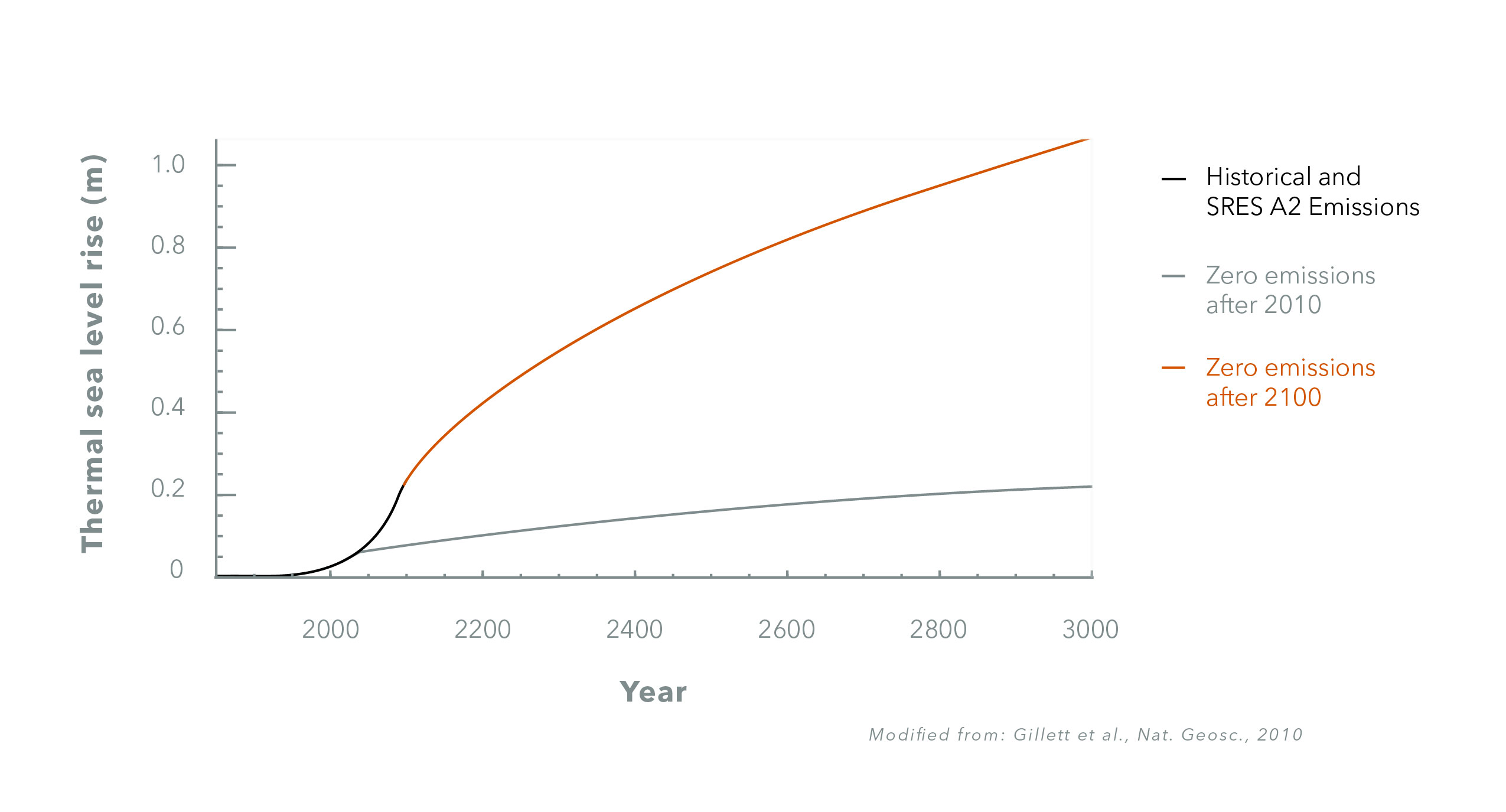Research in SFU's Climate Research Lab investigates the effects of human activities on climate on multi-century timescales using Earth System Models of different complexity. Currently, research in the lab focuses on four broad themes, listed below.
Reversibility of human-induced climate change
Is global warming reversible, i.e. is it possible to restore the climate system to a desired state if human-induced emissions of greenhouse gases are reduced or completely eliminated? Climate change is potentially irreversible because of the long (centennial to millennial) time carbon dioxide (CO2) remains in the atmosphere, and the long reaction timescales of the deep ocean and ice sheets. Recent research has shown that human-induced climate change is largely irreversible (i.e. temperature will remain elevated and sea level will continue to rise) for several centuries even after emissions of greenhouse gases are stopped entirely. Against this evidence, technology that seeks to artificially remove CO2 from the atmosphere (which would slow the rate of increase of CO2 in the atmosphere and accelerate the atmospheric CO2 concentration decrease after a peak has been reached) is increasingly discussed. Research in my group explores whether carbon dioxide removal technology has the potential to enhance the reversibility of different components of the climate system (e.g. ocean, permafrost), given realistic constraints on the rate and scale this technology can be applied at.
Carbon cycle response to carbon dioxide removal
Under the 2015 Paris Agreement nations committed to “holding the increase in the global average surface temperature to well below 2°C above pre-industrial levels and to pursue efforts to limit the temperature increase even further to 1.5°C”. Meeting the temperature target in the Paris Agreement presents the enormous challenge of reducing CO2 emissions to zero within this century. Artificial removal of CO2 from the atmosphere (referred to as “carbon dioxide removal” or CDR) is a key mitigation measure in greenhouse gas emission scenarios that seek to limit global warming to 1.5°C or 2°C. Yet, our understanding of the carbon cycle response to CDR is limited. Research in my group seeks to better understand the processes that determine the response of the coupled climate-carbon cycle to CDR both at the global and regional scale, and their uncertainty in models. We also seek to develop metrics to quantify the effectiveness of CDR in lowering atmospheric CO2 and reversing human-induced warming.
Carbon budgets consistent with climate targets
Recent research has established that global warming at a given point in time is determined by the total amount of CO2 emissions emitted up to that time, and is independent of the emission trajectory. The proportional relationship between global warming and total or “cumulative” CO2 emissions arises because of compensation of different processes within the coupled climate-carbon cycle system. The total CO2 emissions that can be emitted over all times in order to limit global warming to a given level – e.g. the 1.5°C and 2°C limits mentioned in the Paris Agreement – is referred to as “carbon budget”. Carbon budgets are uncertain because the physical and biogeochemical response to CO2 emissions is not well constrained, and because it is uncertain how emissions of other greenhouse gases will evolve in the future. The method of quantification also influences the magnitude of carbon budgets. Research in my group investigates the physical and biogeochemical processes underlying the carbon budget concept, and seeks to quantify carbon budgets consistent with climate targets under consideration of a range of uncertainties.
Feedbacks between climate and the carbon cycle
A range of feedbacks operate in the climate system, which have the potential attenuate or exacerbate global warming. One class of feedbacks involves the carbon cycle, and determines how much of the carbon dioxide (CO2) emitted by human activities remains in the atmosphere. For example, the solubility of CO2 in seawater decreases with temperature. Therefore, if the temperature of seawater rises, the ocean will be able to absorb less CO2. Similar feedbacks operate in the terrestrial carbon cycle. A prominently discussed feedback is the permafrost-carbon feedback, whereby permanently frozen soils thaw due to warming, releasing CO2 and methane into the atmosphere. These gases, in turn, amplify the greenhouse effect, leading to additional warming. Research suggests that the total effect of carbon-climate feedbacks is to amplify global warming (i.e. a positive feedback), but no runaway carbon-climate feedbacks are anticipated, at least this century. Research in my group seeks to better understand the physical and biogeochemical processes that generate these feedbacks, and quantify them.




